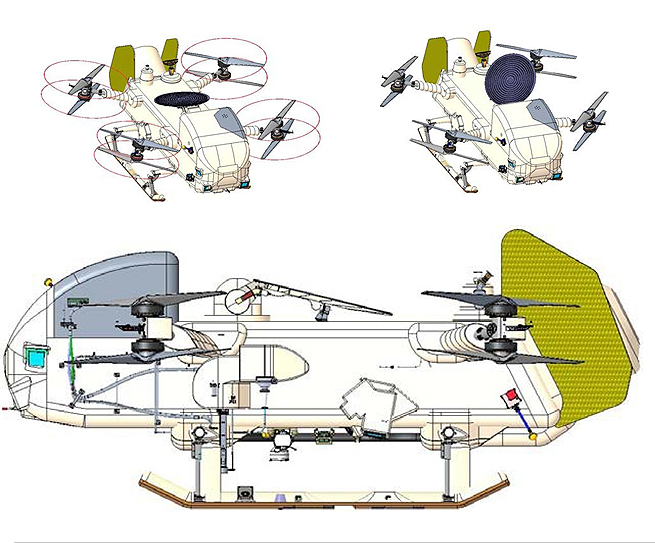A Revolutionary Rotorcraft Lander
The Dragonfly rotorcraft lander is no ordinary drone. Weighing about 1,900 pounds (875 kilograms), Dragonfly will be about 12.5 feet (3.85 meters) long, 12.5 feet (3.85 meters) wide and more than 5.5 feet (1.75 meters) tall, carried by eight sets of 53-inch (1.35-meter) long rotors. The Dragonfly body consists of aluminum panels and interior decks as well as aluminum honeycomb fuselage skin, with a polymethacrylimide-based foam covering the fuselage. It’ll be powered by a 134 ampere-hour battery and multimission radioisotope thermoelectric generator (MMRTG). Heat from the MMRTG will also enable conductive thermal control on the way to Titan, and convective thermal control when Dragonfly operates at Titan.
Dragonfly will communicate directly with operators on Earth through NASA’s Deep Space Network, enabled by a large-gain antenna, a medium-gain antenna, a 100-watt traveling-wave tube amplifier and Johns Hopkins APL-designed Frontier radio (X-band only).
At Titan, Dragonfly will rely on a mobility system that includes lidar (light-detection and ranging), inertial measurement units, navigation cameras, pressure sensors and wind sensors.
Science Payload
Dragonfly centers on a game-changing approach to planetary exploration, employing a rotorcraft-lander to travel between and sample diverse sites on Saturn’s largest moon. With contributions from partners around the globe, Dragonfly’s scientific payload will characterize the habitability of Titan's environment, investigate the progression of prebiotic chemistry in an environment where carbon-rich material and liquid water may have mixed for an extended period, and even search for chemical indications of whether water-based or hydrocarbon-based life once existed on Titan.
DraMS: Mass Spectrometer
Development: NASA Goddard Space Flight Center, National Centre for Space Studies (CNES, France)
Job at Titan: Analyze chemical components and processes that produce biologically relevant compounds.
DrACO: Drill for Acquisition of Complex Organics
Development: Honeybee Robotics
Job at Titan: Rotary-percussive drill to sample and pneumatically transfer surface material to DraMS
DraGNS: Gamma-ray and Neutron Spectrometer
Development: Johns Hopkins APL, Lawrence Livermore National Laboratory
Job at Titan: Measure bulk elemental surface composition, including minor inorganics, to classify surface materials
DraGMet: Geophysics and Meteorology
Development: Johns Hopkins APL, Japan Aerospace Exploration Agency (JAXA)
Job at Titan: Monitor atmospheric conditions, constrain regolith properties, detect and characterize level of seismic activity
DragonCam: Camera Suite
Development: Malin Space Science Systems
Job at Titan: Characterize landforms and surface processes at multiple scales, surface and aerial imaging




